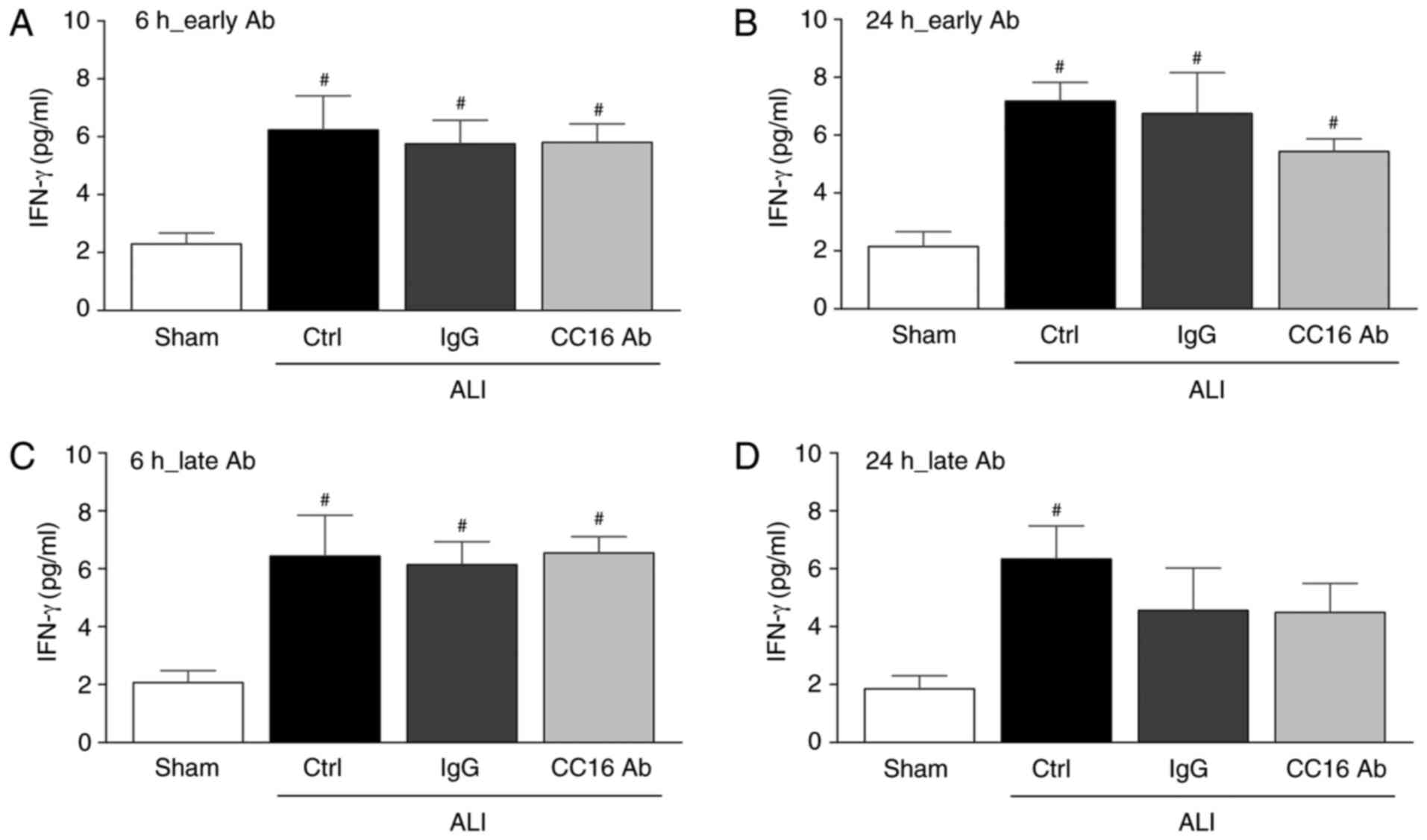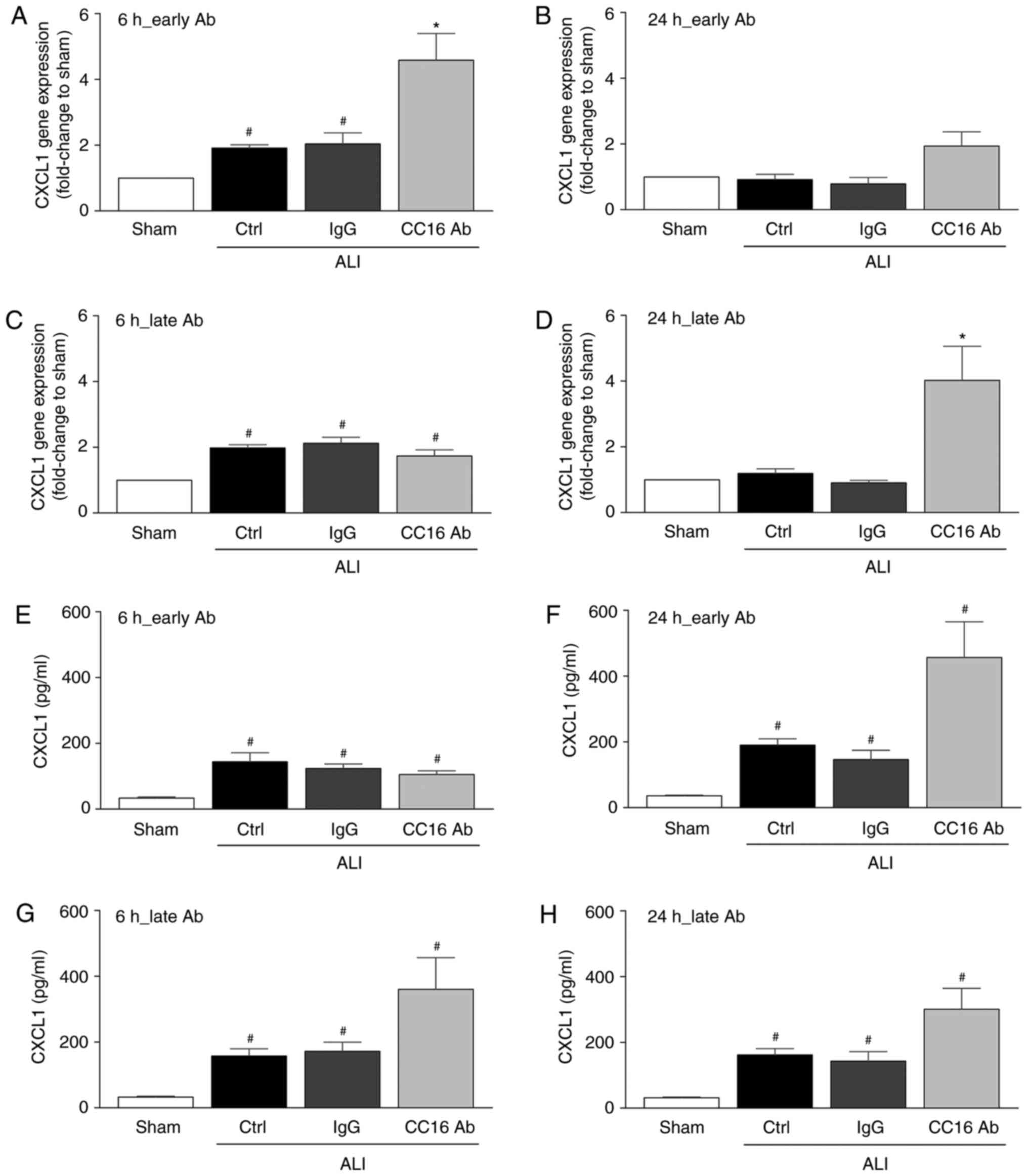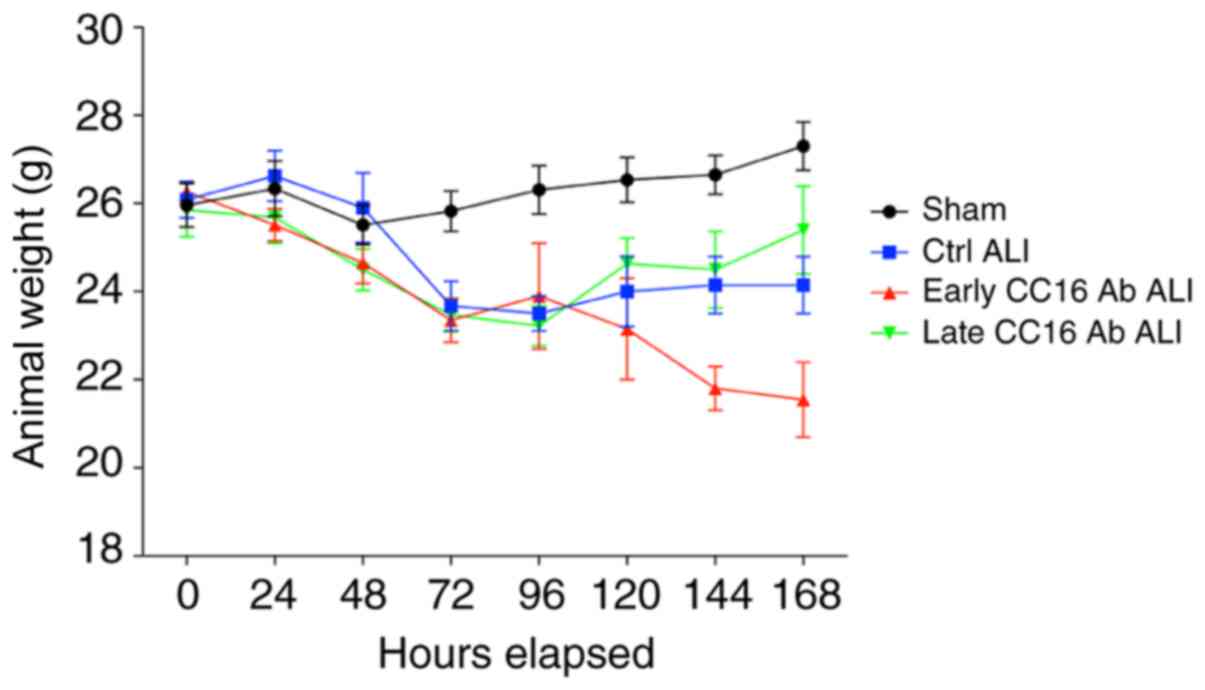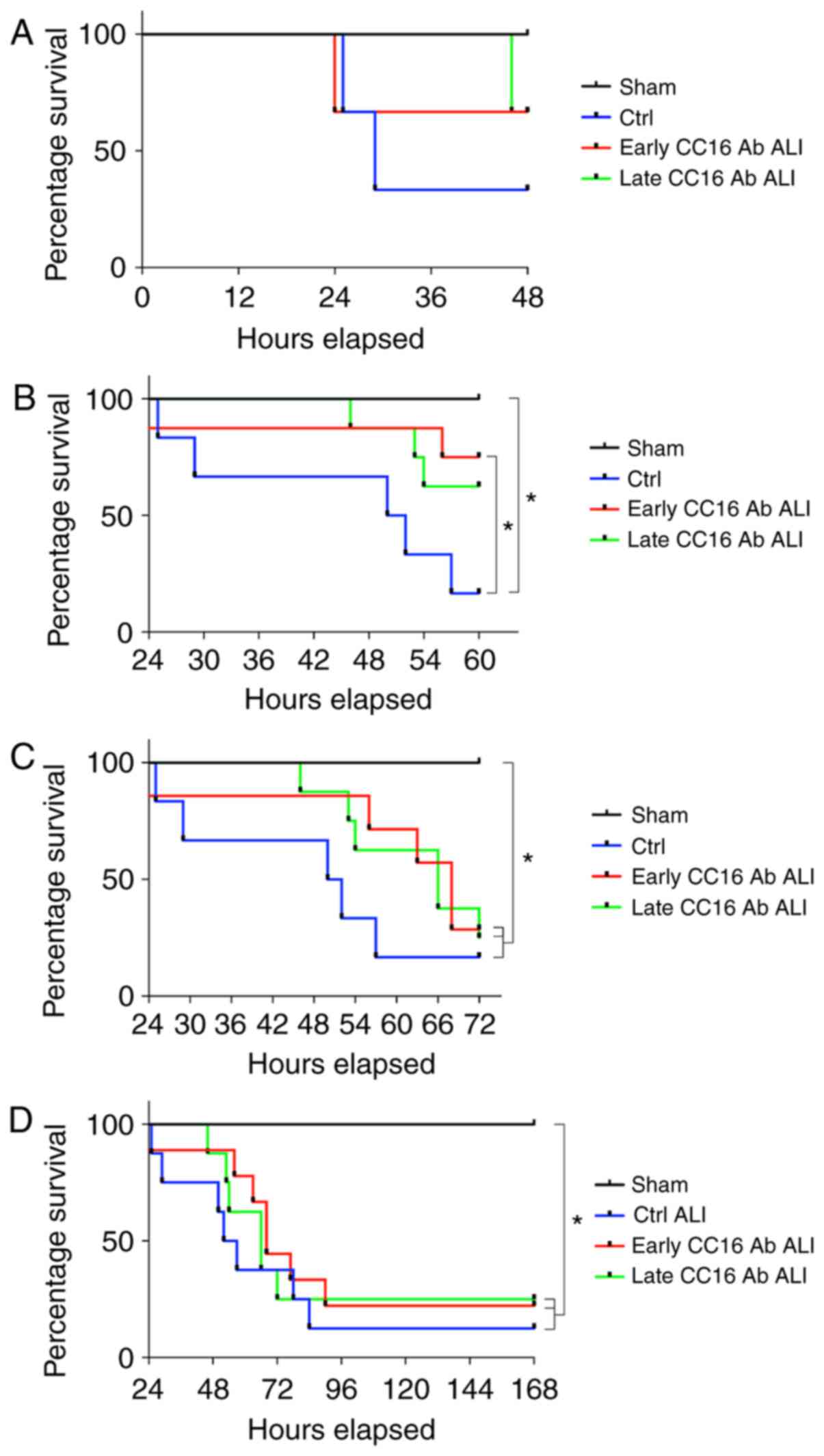|
1
|
Hildebrand F, Giannoudis PV, Griensven M,
Zelle B, Ulmer B, Krettek C, Bellamy MC and Pape HC: Management of
poly-traumatized patients with associated blunt chest trauma: A
comparison of two European countries. Injury. 36:293–302. 2005.
View Article : Google Scholar : PubMed/NCBI
|
|
2
|
Matthay MA, Zemans RL, Zimmerman GA, Arabi
YM, Beitler JR, Mercat A, Herridge M, Randolph AG and Calfee CS:
Acute respiratory distress syndrome. Nat Rev Dis Primers. 5:182019.
View Article : Google Scholar : PubMed/NCBI
|
|
3
|
Rendeki S and Molnár TF: Pulmonary
contusion. J Thorac Dis. 11(Suppl 2): S141–S151. 2019. View Article : Google Scholar : PubMed/NCBI
|
|
4
|
Hoth JJ, Wells JD, Yoza BK and McCall CE:
Innate immune response to pulmonary contusion: Identification of
cell type-specific inflammatory responses. Shock. 37:385–391. 2012.
View Article : Google Scholar : PubMed/NCBI
|
|
5
|
Hoth JJ, Wells JD, Brownlee NA, Hiltbold
EM, Meredith JW, McCall CE and Yoza BK: Toll-like receptor
4-dependent responses to lung injury in a murine model of pulmonary
contusion. Shock. 31:376–31. 2009. View Article : Google Scholar
|
|
6
|
Hoth JJ, Wells JD, Hiltbold EM, McCall CE
and Yoza BK: Mechanism of neutrophil recruitment to the lung after
pulmonary contusion. Shock. 35:604–609. 2011. View Article : Google Scholar : PubMed/NCBI
|
|
7
|
Störmann P, Becker N, Kunnemeyer L,
Wutzler S, Vollrath JT, Lustenberger T, Hildebrand F, Marzi I and
Relja B: Contributing factors in the development of acute lung
injury in a murine double hit model. Eur J Trauma Emerg Surg.
46:21–30. 2020. View Article : Google Scholar
|
|
8
|
Proudfoot AG, McAuley DF, Griffiths MJ and
Hind M: Human models of acute lung injury. Dis Model Mech.
4:145–153. 2011. View Article : Google Scholar : PubMed/NCBI
|
|
9
|
Störmann P, Becker N, Vollrath JT, Köhler
K, Janicova A, Wutzler S, Hildebrand F, Marzi I and Relja B: Early
local inhibition of club cell protein 16 following chest trauma
reduces late sepsis-induced acute lung injury. J Clin Med.
8:8962019. View Article : Google Scholar :
|
|
10
|
Perl M, Hohmann C, Denk S, Kellermann P,
Lu D, Braumuller S, Bachem MG, Thomas J, Knöferl MW, Ayala A, et
al: Role of activated neutrophils in chest trauma-induced septic
acute lung injury. Shock. 38:98–106. 2012. View Article : Google Scholar : PubMed/NCBI
|
|
11
|
Weckbach S, Hohmann C, Denk S, Kellermann
P, Huber-Lang MS, Baumann B, Wirth T, Gebhard F, Bachem M and Perl
M: Apoptotic and inflammatory signaling via Fas and tumor necrosis
factor receptor I contribute to the development of chest
trauma-induced septic acute lung injury. J Trauma Acute Care Surg.
74:792–800. 2013. View Article : Google Scholar : PubMed/NCBI
|
|
12
|
Muenzer JT, Davis CG, Chang K, Schmidt RE,
Dunne WM, Coopersmith CM and Hotchkiss RS: Characterization and
modulation of the immunosuppressive phase of sepsis. Infect Immun.
78:1582–1592. 2010. View Article : Google Scholar : PubMed/NCBI
|
|
13
|
Boehm U, Klamp T, Groot M and Howard JC:
Cellular responses to interferon-gamma. Annu Rev Immunol.
15:749–795. 1997. View Article : Google Scholar : PubMed/NCBI
|
|
14
|
Varma TK, Lin CY, Toliver-Kinsky TE and
Sherwood ER: Endotoxin-induced gamma interferon production:
Contributing cell types and key regulatory factors. Clin Diagn Lab
Immunol. 9:530–543. 2002.PubMed/NCBI
|
|
15
|
Shtrichman R and Samuel CE: The role of
gamma interferon in antimicrobial immunity. Curr Opin Microbiol.
4:251–259. 2001. View Article : Google Scholar : PubMed/NCBI
|
|
16
|
Romero CR, Herzig DS, Etogo A, Nunez J,
Mahmoudizad R, Fang G, Murphey ED, Toliver-Kinsky T and Sherwood
ER: The role of interferon-γ in the pathogenesis of acute
intra-abdominal sepsis. J Leukoc Biol. 88:725–735. 2010. View Article : Google Scholar : PubMed/NCBI
|
|
17
|
Kropski JA, Fremont RD, Calfee CS and Ware
LB: Clara cell protein (CC16), a marker of lung epithelial injury,
is decreased in plasma and pulmonary edema fluid from patients with
acute lung injury. Chest. 135:1440–1447. 2009. View Article : Google Scholar : PubMed/NCBI
|
|
18
|
Miele L, Cordella-Miele E, Mantile G, Peri
A and Mukherjee AB: Uteroglobin and uteroglobin-like proteins: The
uteroglobin family of proteins. J Endocrinol Invest. 17:679–692.
1994. View Article : Google Scholar : PubMed/NCBI
|
|
19
|
Negrin LL, Halat G, Kettner S, Gregori M,
Ristl R, Hajdu S and Heinz T: Club cell protein 16 and cytokeratin
fragment 21-1 as early predictors of pulmonary complications in
polytraumatized patients with severe chest trauma. PLoS One.
12:e01753032017. View Article : Google Scholar : PubMed/NCBI
|
|
20
|
Wutzler S, Lehnert T, Laurer H, Lehnert M,
Becker M, Henrich D, Vogl T and Marzi I: Circulating levels of
Clara cell protein 16 but not surfactant protein D identify and
quantify lung damage in patients with multiple injuries. J Trauma.
71:E31–E36. 2011. View Article : Google Scholar
|
|
21
|
Broeckaert F, Clippe A, Knoops B, Hermans
C and Bernard A: Clara cell secretory protein (CC16): Features as a
peripheral lung biomarker. Ann NY Acad Sci. 923:68–77. 2000.
View Article : Google Scholar
|
|
22
|
Relja B, Mörs K and Marzi I: Danger
signals in trauma. Eur J Trauma Emerg Surg. 44:301–316. 2018.
View Article : Google Scholar : PubMed/NCBI
|
|
23
|
Wutzler S, Lustenberger T, Relja B,
Lehnert M and Marzi I: Pathophysiology of multiple trauma:
Intensive care medicine and timing of treatment. Chirurg.
84:753–758. 2013.In German. View Article : Google Scholar : PubMed/NCBI
|
|
24
|
Dong L, Zhu YH, Liu DX, Li J, Zhao PC,
Zhong YP, Chen YQ, Xu W and Zhu ZQ: Intranasal application of
budesonide attenuates lipopolysaccharide-induced acute lung injury
by suppressing nucleotide-binding oligomerization domain-like
receptor family, pyrin domain-containing 3 inflammasome activation
in mice. J Immunol Res. 2019:72643832019. View Article : Google Scholar : PubMed/NCBI
|
|
25
|
Horiguchi H, Loftus TJ, Hawkins RB,
Raymond SL, Stortz JA, Hollen MK, Weiss BP, Miller ES, Bihorac A,
Larson SD, et al: Innate immunity in the persistent inflammation,
immunosuppression, and catabolism syndrome and its implications for
therapy. Front Immunol. 9:5952018. View Article : Google Scholar : PubMed/NCBI
|
|
26
|
Kilkenny C, Browne WJ, Cuthill IC, Emerson
M and Altman DG: Improving bioscience research reporting: The
ARRIVE guidelines for reporting animal research. PLoS Biol.
8:e10004122010. View Article : Google Scholar : PubMed/NCBI
|
|
27
|
Knoferl MW, Liener UC, Seitz DH, Perl M,
Bruckner UB, Kinzl L and Gebhard F: Cardiopulmonary, histological,
and inflammatory alterations after lung contusion in a novel mouse
model of blunt chest trauma. Shock. 19:519–525. 2003. View Article : Google Scholar : PubMed/NCBI
|
|
28
|
Rittirsch D, Huber-Lang MS, Flierl MA and
Ward PA: Immunodesign of experimental sepsis by cecal ligation and
puncture. Nat Protoc. 4:31–36. 2009. View Article : Google Scholar : PubMed/NCBI
|
|
29
|
Janicova A, Becker N, Xu B, Wutzler S,
Vollrath JT, Hildebrand F, Ehnert S, Marzi I, Störmann P and Relja
B: Endogenous utero-globin as intrinsic anti-inflammatory signal
modulates monocyte and macrophage subsets distribution upon sepsis
induced lung injury. Front Immunol. 10:22762019. View Article : Google Scholar
|
|
30
|
Relja B, Horstmann JP, Kontradowitz K,
Jurida K, Schaible A, Neunaber C, Oppermann E and Marzi I: Nlrp1
inflammasome is downregulated in trauma patients. J Mol Med (Berl).
93:1391–1400. 2015. View Article : Google Scholar
|
|
31
|
Livak KJ and Schmittgen TD: Analysis of
relative gene expression data using real-time quantitative PCR and
the 2(−Delta Delta C(T)) method. Methods. 25:402–408. 2001.
View Article : Google Scholar
|
|
32
|
Pang M, Liu HY, Li T, Wang D, Hu XY, Zhang
XR, Yu BF, Guo R and Wang HL: Recombinant club cell protein 16
(CC16) ameliorates cigarette smoke-induced lung inflammation in a
murine disease model of COPD. Mol Med Rep. 18:2198–2206.
2018.PubMed/NCBI
|
|
33
|
Laucho-Contreras ME, Polverino F, Gupta K,
Taylor KL, Kelly E, Pinto-Plata V, Divo M, Ashfaq N, Petersen H,
Stripp B, et al: Protective role for club cell secretory protein-16
(CC16) in the development of COPD. Eur Respir J. 45:1544–1556.
2015. View Article : Google Scholar : PubMed/NCBI
|
|
34
|
Seitz DH, Perl M, Liener UC, Tauchmann B,
Braumüller ST, Brückner UB, Gebhard F and Knöferl MW: Inflammatory
alterations in a novel combination model of blunt chest trauma and
hemorrhagic shock. J Trauma. 70:189–196. 2011. View Article : Google Scholar
|
|
35
|
Reutershan J and Ley K: Bench-to-bedside
review: Acute respiratory distress syndrome-how neutrophils migrate
into the lung. Crit Care. 8:453–461. 2004. View Article : Google Scholar : PubMed/NCBI
|
|
36
|
Miller EJ, Cohen AB, Nagao S, Griffith D,
Maunder RJ, Martin TR, Weiner-Kronish JP, Sticherling M,
Christophers E and Matthay MA: Elevated levels of
NAP-1/interleukin-8 are present in the airspaces of patients with
the adult respiratory distress syndrome and are associated with
increased mortality. Am Rev Respir Dis. 146:427–432. 1992.
View Article : Google Scholar : PubMed/NCBI
|
|
37
|
Folkesson HG, Matthay MA, Hebert CA and
Broaddus VC: Acid aspiration-induced lung injury in rabbits is
mediated by interleukin-8-dependent mechanisms. J Clin Invest.
96:107–116. 1995. View Article : Google Scholar : PubMed/NCBI
|
|
38
|
Reutershan J, Morris MA, Burcin TL, Smith
DF, Chang D, Saprito MS and Ley K: Critical role of endothelial
CXCR2 in LPS-induced neutrophil migration into the lung. J Clin
Invest. 116:695–702. 2006. View Article : Google Scholar : PubMed/NCBI
|
|
39
|
Belperio JA, Keane MP, Burdick MD, Londhe
V, Xue YY, Li K, Phillips RJ and Strieter RM: Critical role for
CXCR2 and CXCR2 ligands during the pathogenesis of
ventilator-induced lung injury. J Clin Invest. 110:1703–1716. 2002.
View Article : Google Scholar : PubMed/NCBI
|
|
40
|
Meng J, Zou Y, Chen J, Qin F, Chen X, Chen
X and Dai S: sTLR4/sMD-2 complex alleviates LPS-induced acute lung
injury by inhibiting pro-inflammatory cytokines and chemokine CXCL1
expression. Exp Ther Med. 16:4632–4638. 2018.PubMed/NCBI
|
|
41
|
Wang J, Gong S, Wang F, Niu M, Wei G, He
Z, Gu T, Jiang Y, Liu A and Chen P: Granisetron protects
polymicrobial sepsis-induced acute lung injury in mice. Biochem
Biophys Res Commun. 508:1004–1010. 2019. View Article : Google Scholar
|
|
42
|
Zarbock A, Allegretti M and Ley K:
Therapeutic inhibition of CXCR2 by Reparixin attenuates acute lung
injury in mice. Br J Pharmacol. 155:357–364. 2008. View Article : Google Scholar : PubMed/NCBI
|
|
43
|
Dunn JLM, Kartchner LB, Stepp WH, Glenn
LI, Malfitano MM, Jones SW, Doerschuk CM, Maile R and Cairns BA:
Blocking CXCL1-dependent neutrophil recruitment prevents immune
damage and reduces pulmonary bacterial infection after inhalation
injury. Am J Physiol Lung Cell Mol Physiol. 314:L822–L834. 2018.
View Article : Google Scholar : PubMed/NCBI
|
|
44
|
Niesler U, Palmer A, Radermacher P and
Huber-Lang MS: Role of alveolar macrophages in the inflammatory
response after trauma. Shock. 42:3–10. 2014. View Article : Google Scholar : PubMed/NCBI
|
|
45
|
Dierynck I, Bernard A, Roels H and De Ley
M: Potent inhibition of both human interferon-gamma production and
biologic activity by the Clara cell protein CC16. Am J Respir Cell
Mol Biol. 12:205–210. 1995. View Article : Google Scholar : PubMed/NCBI
|
|
46
|
Magdaleno SM, Wang G, Jackson KJ, Ray MK,
Welty S, Costa RH and DeMayo FJ: Interferon-gamma regulation of
Clara cell gene expression: In vivo and in vitro. Am J Physiol.
272:L1142–L1151. 1997.PubMed/NCBI
|
|
47
|
Ramsay PL, Luo Z, Magdaleno SM, Whitbourne
SK, Cao X, Park MS, Park MS, Welty SE, Yu-Lee LY and DeMayo FJ:
Transcriptional regulation of CCSP by interferon-gamma in vitro and
in vivo. Am J Physiol Lung Cell Mol Physiol. 284:L108–L118. 2003.
View Article : Google Scholar
|
|
48
|
Michel O, Murdoch R and Bernard A: Inhaled
LPS induces blood release of Clara cell specific protein (CC16) in
human beings. J Allergy Clin Immunol. 115:1143–1147. 2005.
View Article : Google Scholar : PubMed/NCBI
|
|
49
|
Lam DC, Kwok HH, Yu WC, Ko FW, Tam CY, Lau
AC, Fong DY and Ip MS: CC16 levels correlate with cigarette smoke
exposure in bronchial epithelial cells and with lung function
decline in smokers. BMC Pulm Med. 18:472018. View Article : Google Scholar : PubMed/NCBI
|
|
50
|
Xu L, Zhang W, Kwak M, Zhang L, Lee PCW
and Jin JO: Protective effect of melatonin against polymicrobial
sepsis is mediated by the anti-bacterial effect of neutrophils.
Front Immunol. 10:13712019. View Article : Google Scholar : PubMed/NCBI
|
|
51
|
Chen X, Wang T, Song L and Liu X:
Activation of multiple Toll-like receptors serves different roles
in sepsis-induced acute lung injury. Exp Ther Med. 18:443–450.
2019.PubMed/NCBI
|
|
52
|
Matsuo S, Sharma A, Wang P and Yang WL:
PYR-41, a ubiq-uitin-activating enzyme E1 inhibitor, attenuates
lung injury in sepsis. Shock. 49:442–450. 2018. View Article : Google Scholar
|
|
53
|
Vourc'h M, Roquilly A and Asehnoune K:
Trauma-induced damage-associated molecular patterns-mediated remote
organ injury and immunosuppression in the acutely ill patient.
Front Immunol. 9:13302018. View Article : Google Scholar : PubMed/NCBI
|
|
54
|
Matute-Bello G, Frevert CW and Martin TR:
Animal models of acute lung injury. Am J Physiol Lung Cell Mol
Physiol. 295:L379–L399. 2008. View Article : Google Scholar : PubMed/NCBI
|



















